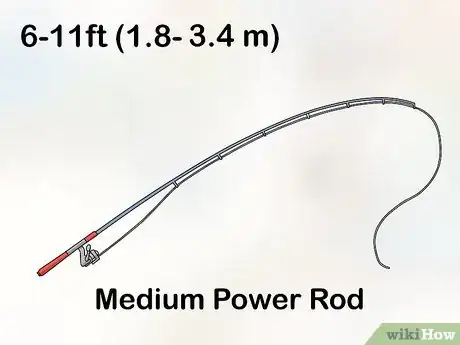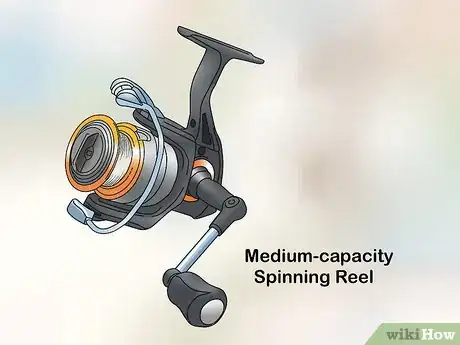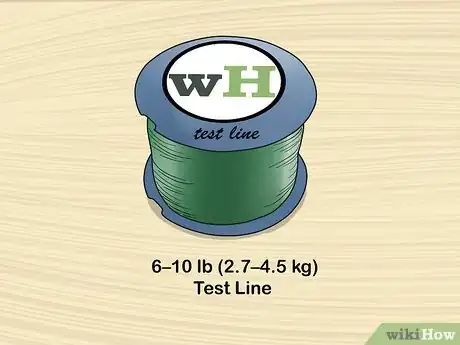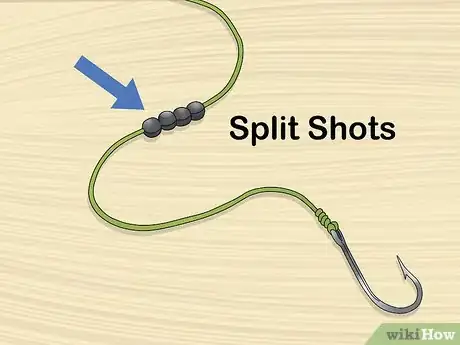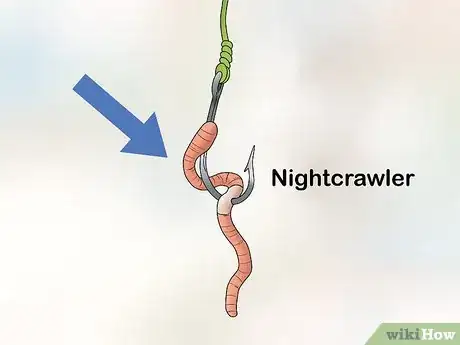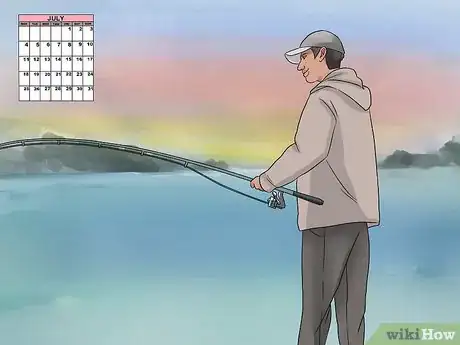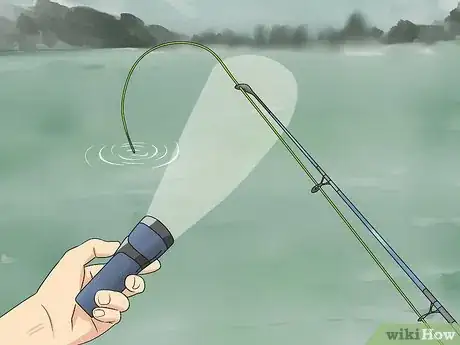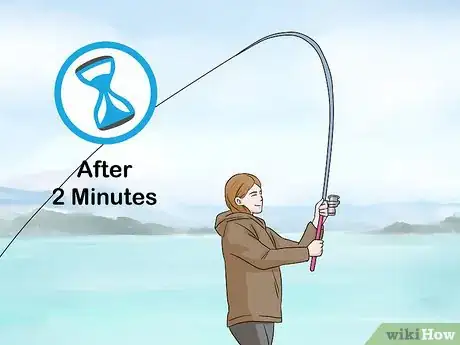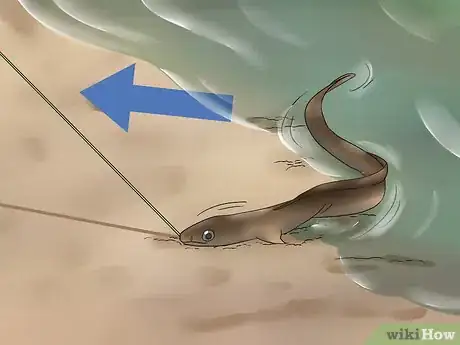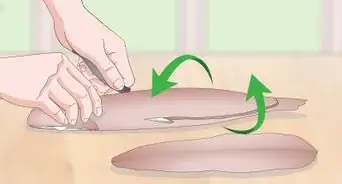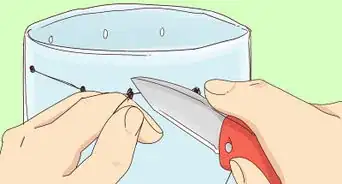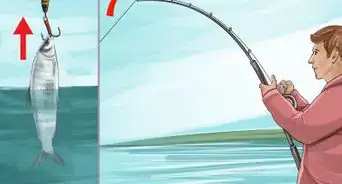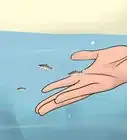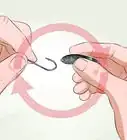This article was co-authored by wikiHow Staff. Our trained team of editors and researchers validate articles for accuracy and comprehensiveness. wikiHow's Content Management Team carefully monitors the work from our editorial staff to ensure that each article is backed by trusted research and meets our high quality standards.
There are 8 references cited in this article, which can be found at the bottom of the page.
This article has been viewed 46,678 times.
Learn more...
If you are up for a challenge, try fishing for eels in freshwater throughout North America and Europe. Eels are easily caught if you know when to fish for them and what they like to eat. You can fish for eels during the day or at night, and they are best to fish for during the summertime. Tie your hooks and weight to your line, bait your hook with a large nightcrawler, and make your cast. When you feel a nibble, set your hook and get ready for a fight!
Steps
Setting up Your Rig
-
1Select a 6–11 ft (1.8–3.4 m) medium power spinning rod. A shorter rod length will give you greater leverage after hooking the eel, which is especially important since eels are known to be ferocious fighters. A medium power rod will also protect your rod from snapping during the eel fishing process.[1]
- Use longer rods if you want to catch longer eels.
-
2Pick a medium-capacity spinning reel. You can purchase this at a bait, tackle, or outdoors store. Medium-capacity spinning reels work great for catching eels because they allow you reel in quickly without any hesitation.[2]
- They are commonly used by beginner fishermen as well.
Advertisement -
3Use 6–10 lb (2.7–4.5 kg) test line. When fishing for eels, you need a line that can withstand their tugging and thrashing. Go with 10 lb (4.5 kg) test line to give you the most secure line, though 6 lb (2.7 kg) and 8 lb (3.6 kg) line also works well for eel fishing. Select abrasion-resistant monofilament line for best results. [3]
-
4Attach a no.4 hook to your line using a cinch knot. To secure your hook, run your line through your hook, and bring the end of your line towards your hook to make a loop. Twist 5 “S” shapes around your line, and bring the end towards your hook. Push your knot through the first loop you made before the “S” twists. Then, pull your knot to tighten it.[4]
- You can use hooks no.6 - no.2 if you don’t have a no.4 hook.
- When eel fishing, you want to use a hook about the size of the eel’s mouth.
- A cinch knot ensures your hook will not fall off the line. You want to use a tight, secure knot for eel fishing so they don’t snap your line.
-
5Crimp 2-4 split shots onto your line about 1 ft (0.30 m) above the hook. After you secure your hook to the line, place a split shot around your line, take a pair of pliers, and pinch it into place. Add a few more split shots to your line for additional weight. Split shots help weigh your line to the bottom, which is where eels primarily swim and eat.[5]
- A split shot is a small weight you crimp onto your line.
-
6Use nightcrawlers as your bait and attach 1 to your hook. Eels eat insect larvae, small minnows, dead fish--anything they can find at the bottom. When fishing for eels, nightcrawlers work best. Pierce a large nightcrawler with your hook to attach your bait. Put the worm on your hook, wrap it around, and pierce it 1-2 more times so it stays in place.[6]
- You can purchase your bait at a tackle shop or find your own!
- You can also use oily cut-bait and chicken liver to attract eels.
- To further tempt the eel, leave a bit of your worm dangling from the hook.
Finding a Spot
-
1Fish during day to try to catch eels when they are hiding. During the day, eels hide in mud and under rocks and logs. If you want to fish for eels during the day, cast your line to the bottom in hopes that your bait sits above the eel’s hiding spots, like at the entrance of a hole or near a large rock.
- Daytime fishing is also referred to as "sniggling."[7]
-
2Fish at night to catch eels when they are feeding. At twilight eels start to nibble, and by nightfall eels are ready to eat. While you can fish for eels during the day, they are often sleeping rather than looking for food. Night fishing for eels is a fun challenge and you are likely to catch more eels than during the day![8]
- Eels prefer to feed when it is totally dark outside to avoid being seen.
-
3Go fishing on summer nights to increase your chances of catching eels. Eels are most active during hot and humid nights in the summer, and they have quite the appetite in the summer compared to the other seasons. In summer months, you are likely to find eels on the hunt for food during the day and at night.[9]
- You can also fish for eels in other seasons, but the summertime is when they are the most active and concentrated in 1 area.
-
4Pick a spot near high, muddy water. Eels prefer to be active when the water level is high and the bottom of the lakes and rivers are murky. This is so they can best be concealed in the water and feed for prey. Great eel fishing spots include deep riverbeds next to muddy sections of water. Look for muddy sections of water, and fish when the lakes or rivers are most full.[10]
- You can fish for eels shortly after a large thunderstorm, for example.
-
5Look for slow moving water or holes off of riverbeds. Eels prefer to feed in water without a strong current. Pick a spot where the water is slow moving and fairly deep. You can also look for holes on the side of riverbeds, where eels may be hanging out. These are all good spots to fish for eels.[11]
- Good eel fishing spots include rivers, reservoirs, ponds, and canals.
- In ponds and lakes, you can cast into shallow flats next to deep water.
- In rivers, you can look for quiet backwater near deep areas.
Casting and Reeling
-
1Cast your line into the water as far as you can. You want to cast far when fishing for eels because they like to spend time in deep, murky water. Press down on the reel release button and raise up your casting arm over your shoulder. Release the button to make your cast! [12]
- To make your cast, move your arm quickly and consistently.
- Try to keep your feet stationary and raise your rod by moving your hips. That way, your rod will have a bit more momentum as you make your cast.
-
2Let your rig settle to bottom after you make your cast.The split shots weigh down your rig and bring your bait to the bottom, where the eels primarily eat, swim, and sleep.
- Most eels don't venture too far from their hiding place when feeding, so they are more likely to find your bait if it reaches the bottom of a lake or river.
-
3Aim your flashlight at the tip of your rod and look for subtle changes. This can help you notice any small tugs on the line. Eels often nudge at bait before biting it, so small bobs in the tip of your rod may be an indication that a bite is coming!
- While this is not required, it will help you see any movements on the tip of your rod.
-
4Recast if you don’t have a bite within 2 minutes. Eels usually nibble on bait quickly, so if you don’t get a bite within the first few minutes of your cast, try casting again. Eels will spend time hiding out rather than swimming about, so they may not notice your bait the first time you cast.
- Try casting in a spot 1–2 ft (0.30–0.61 m) away from where your first cast landed.
- Recasting helps the eels notice fresh bait.
-
5Set the hook when you feel 2 tugs on the line. When you have an eel on your line, pull back quickly and firmly on the tip of the rod. This helps secure the fish on your hook. Your eel will start to pull back and escape as soon as you set them, so be ready for any sudden jerks or pulls.[13]
- Eels will nibble on their food before they take large bites, so wait until after you feel 1 tug before you make your move.
-
6Reel in the eel gradually as the eel tires out. As the eel fights back, reel in your rod a few times (for about 5 seconds or so) to bring it closer to the surface. Then, reel a little bit more until you can see it from the surface of the water. It will continue to pull your line as you reel it in, though don't give up![14]
- Eels put up a fight when caught, so gradually reeling them in works best to bring them in without damaging your line, reel, or rod.
-
7Be ready for the eel to pull back and thrust about! Eels can be challenging to bring in because they often fight for awhile before you reel them in. They will tug your line and thrash back and forth to try to escape. Stand with your feet firmly on the ground, and keep your rod in your hands at all times.
- They can even snap your line!
-
8Beach the eel on the shore as you reel it in. As you gradually reel it in, bring the eel towards the shoreline you are fishing from. Pick up your eel from shore rather than through the water, as the eel can continue to fight and twist on your line.[15]
- Eels are long and sometimes heavy, and they are much easier to pick up and take out of the water from a shallow area.
- The easiest way to bring in your eel is to slowly bring it towards the shore.
-
9Unhook the eel when you reel it to shore. After you finally get your eel to shore, lift up the eel by your line, and firmly grasp the eel’s head. Grip the hook with your hand or with a pair of pliers, and take it out of the eel’s lip. Be prepared for the eel to trash back and forth as a final escape attempt!
- You can now either bring the eel home to cook or release it back into the wild.
Things You’ll Need
- 6–11 ft (1.8–3.4 m) medium power spinning rod
- Medium-capacity spinning reel
- 6–10 lb (2.7–4.5 kg) monofilament test line
- No. 4 hooks
- Split shots
- Nightcrawlers
- Pliers
- Flashlight
Warnings
- Check local regulations before fishing for eels to make sure it is legal to fish for them in your area. You can look up local regulations online.⧼thumbs_response⧽
References
- ↑ http://www.in-fisherman.com/other-fish/american-eel/catching-and-preparing-american-eels/
- ↑ http://www.in-fisherman.com/other-fish/american-eel/catching-and-preparing-american-eels/
- ↑ http://www.in-fisherman.com/other-fish/american-eel/catching-and-preparing-american-eels/
- ↑ http://www.dec.ny.gov/outdoor/50859.html
- ↑ https://youtu.be/AozNvGXBxUc?t=55s
- ↑ http://www.in-fisherman.com/other-fish/american-eel/catching-and-preparing-american-eels/
- ↑ http://www.publicbookshelf.com/public_html/Boys_Own_Book_of_Outdoor_Sports/eelfishin_dd.html
- ↑ http://www.in-fisherman.com/other-fish/american-eel/catching-and-preparing-american-eels/
- ↑ https://www.outdoorlife.com/how-to-catch-and-eat-eels
- ↑ https://www.outdoorlife.com/how-to-catch-and-eat-eels
- ↑ http://www.in-fisherman.com/other-fish/american-eel/catching-and-preparing-american-eels/
- ↑ https://youtu.be/JXUNxKfGpaA?t=5m10s
- ↑ https://www.outdoorlife.com/how-to-catch-and-eat-eels
- ↑ https://youtu.be/-rumG9W2OWc?t=39s
- ↑ https://youtu.be/-rumG9W2OWc?t=54s
